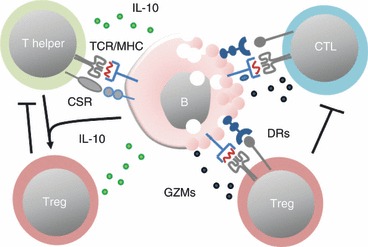Figure 1.

Interactions between T cells and malignant B cells. The malignant B cells may require T helper cells for sustained growth but the helper cells may also be part of the control of malignant cells by direct cytotoxicity or by stimulating anti-tumour immunity. Helper cells can interact via T-cell receptor (TCR)/MHC-II and via co-stimulatory receptors (CSR). The malignant B cells can release substances [such as interleukin-10 (IL-10)] that promote the conversion of T helper cells into regulatory T (Treg) cells that suppress both T helper cells and cytotoxic T cells (CTL). The Treg cells can also recognize MHC-II on the B cells. If cytotoxic, they may interact via death receptors (DRs) to induce B-cell apoptosis. The CTLs recognize MHC-I on malignant B cells and induce apoptosis via DRs. GZMs, granzymes.
